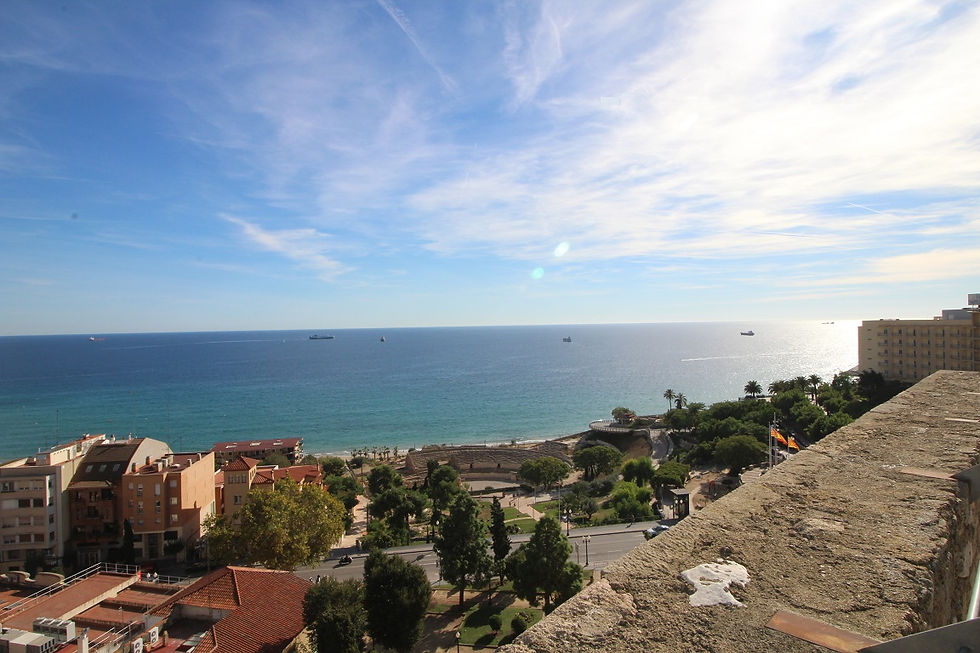CHASING THE ROMANS
- MBA Photography
- 13 dic 2017
- Tempo di lettura: 3 min

Statue at the entrance to the Museum of Tarragona © Mba Photography 2017
In October 2017 we embarked on a cultural trip to Spain chasing the Romans in Tarragona (Latin: Tarraco) . The Roman ruins of Tarraco have been designated a World Heritage Site by UNESCO.Part of the bases of large Cyclopean walls near the Cuartel de Pilatos are thought to pre-date the Romans. The building just mentioned, a prison in the 19th century, is said to have been the palace of Augustus. The second century Tarragona Amphitheatre near the seashore was extensively used as a quarry after the fall of the Western Roman Empire, and but few vestiges of it now remain. A circus c. 450 metres (1,480 ft) long, was built over in the area now called Plaça de la Font, though portions of it are still to be traced. Throughout the town Latin, and even apparently Phoenician, inscriptions on the stones of the houses mark the material used for buildings in the town.
ROMAN AMPHITHEATRE
An oval structure built in the 2nd century overlooking the sea, its stands were carved directly out of the underlying bedrock. The amphitheatre is 109.5 metres long by 86.5 metres wide and can hold up to 14,000 spectators. In its day, it was the scene of fights between gladiators and against wild beasts, as well as public executions. In the year 259 A.D., the Bishop Fructuoso and his deacons Augurio and Eulogio were burned alive within its confines. In the early 6th century, a Visigoth basilica was built on the site, which was eventually replaced by the mediaeval Santa Maria del Miracle (Our Lady of the Miracle) church.

Roman Amphiteatre , view from the gardens © Mba Photography 2017

Roman Amphiteatre , view from above © Mba Photography 2017
THE ROMAN CIRCUS
Located between Via Augusta and the provincial forum, Tarragona's circus was once used to hold horse and chariot races. An elongated structure measuring 325 by 115 metres, its original capacity has been estimated at 30,000 spectators. The complex was built in the 1st century. Unusually, it was located within the city limits and is thus endowed with several atypical architectural features. It is considered one of the best-preserved circuses in the West, although some of the original structure remains hidden under old 19th-century buildings. The Praetorium is a Roman-era tower that once housed the stairs that connected the lower city to the provincial forum by way of the circus, to which it is connected by means of underground passageways. It stands at one of the corners of the vast rectangle of the provincial forum square. In the 12th century, it was transformed into a palace for the monarchs of the Crown of Aragon. It was subsequently used as a prison.

The carving on the ancient walls defines the main access © Mba Photography 2017
What we were most interested in visiting this site was the restoration and modernization project carried out by the Italian architect Andrea Bruno,where as the architect himself says " the reopening of ancient architectures has been implemented under the rediscovery of the peculiarity of the site and the complexity of its stratification. The medieval wall was kept in its general consistency and the design research is focused on the design of the carving to operate to access the restored arches of the ancient masonry only a small section was sacrificed redesigned by a concrete frame".

The circus, in the background an ideal reconstruction hanging from a nearby palace. © Mba Photography 2017

Detail of the masonry cutting made up of the concrete frame that meets with the glass cover that joins the wall with the arches. © Mba Photography 2017

The entrance and the glass cover . © Mba Photography 2017

Underground tunnel access to the stairs. © Mba Photography 2017

View from above of the steps and the corridor underneath in the circular part of the circus. © Mba Photography 2017

The staircase leading to the upper floors and the panoramic terrace.© Mba Photography 2017

Pedestrian walkways and staircase leading to the intermediate terrace.© Mba Photography 2017

View of the town of Tarragona, with the cathedral at the bottom , from the panoramic terrace.
© Mba Photography 2017

View of the Roman Amphiteatre from the panoramic terrace © Mba Photography 2017
We can conclude that surely those who are fascinated by Roman history can not avoid staying in this magnificent city for a few days and enjoy the beautiful monuments and fantastic sea and Mediterranean climate!
Source:http:// www.tarragona.cat/patrimoni/museu-historia/monuments/el-circ-roma,
https://en.wikipedia.org/wiki/Tarragona ;
http:// www.tarragonaturisme.cat/en/monument/praetorium-and-roman-circus-mht
http://www.spanisharts.com/arquitectura/imagenes/roma/tarragona_circo.html
Progetto e Autenticita' by Andrea Bruno ,1999 ed. Del Giglio S.a.s
.jpg)
















Commenti